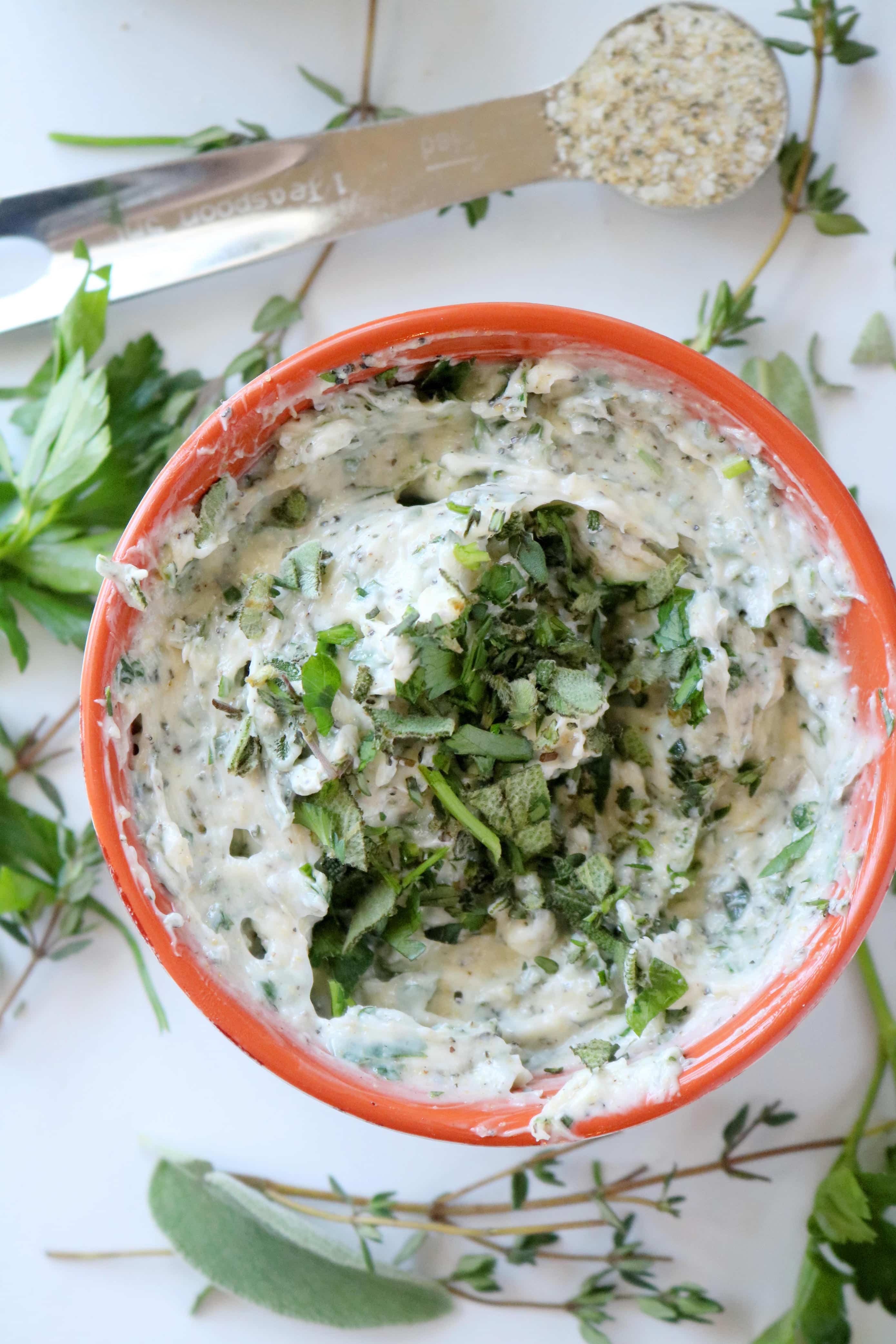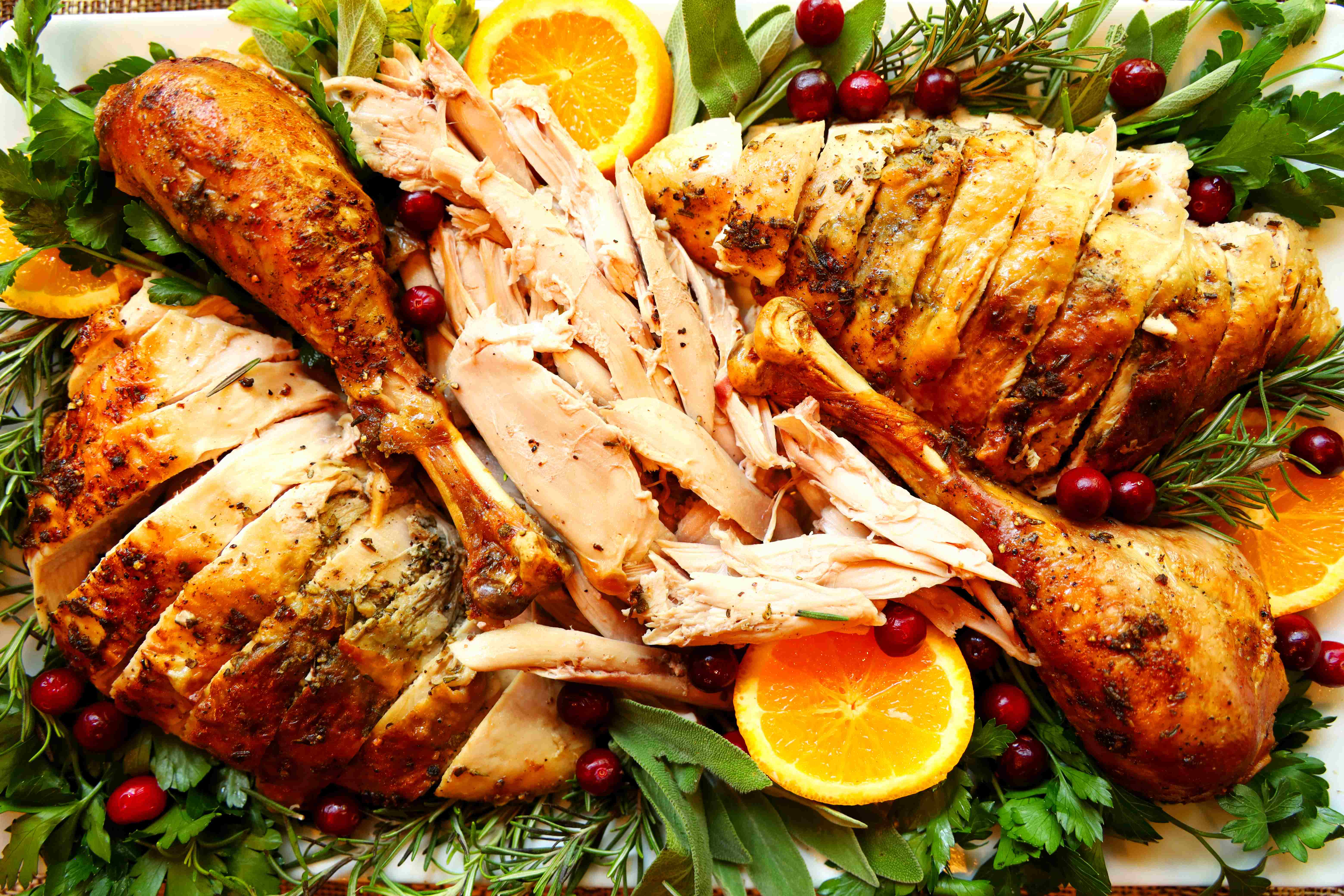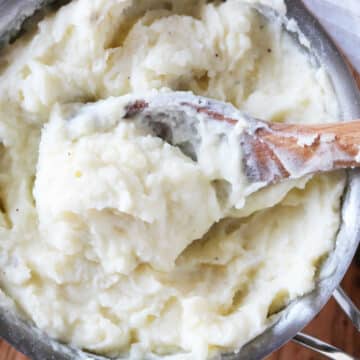This is the ultimate guide for preparing a juicy, flavorful turkey for Thanksgiving Day. Below, you'll find a foolproof Roasted Turkey Recipe covering all the instructions you need for brining, trussing, and roasting your bird to total perfection.

HOW TO ROAST A TURKEY
Below are the essentials you need to slam out a beautiful, moist, and obsessively delicious turkey. Here is a quick overview of your steps:
- Thaw the turkey (3-4 days in the refrigerator).
- Brine the turkey (up to 24 hours).
- Make the compound butter and rub.
- Truss.
- Bake (2 ½ -3 hours, depending on exact weight).
- Rest and serve.
THAW THE TURKEY
First things first, thawing turkey in the refrigerator is the safest way to thaw poultry. You should know a 12-15 pound frozen turkey is going to take about four days to thaw in the refrigerator.
HOW TO BRINE A TURKEY
What is a turkey brine? A simple turkey brine consists of Kosher salt and granulated sugar. The easiest way I've found to put the brine together is to boil the salt, sugar, and water on the stovetop until dissolved. Then, place a brining bag to a roasting pan and have it open, ready and waiting next to the sink.
Once your salt and sugar mixture has cooled, place the prepared turkey breast-side down in the brining bag and pour over mixture to cover. Then, using the faucet or a large pitcher, add water (holding the sides of the brining bag upward to the best of your ability) until the turkey is covered. Seal the brining bag (I use a thick rubber band for good measure) and refrigerate for 24-48 hours before roasting the turkey.
If you have a pot large enough, you can brine the turkey directly in the pot and skip the brining bag altogether.
DO YOU REMOVE THE INNARDS BEFORE BAKING?
One other little thing: now is the time to remove the innards from the cavity of the turkey. If you'd like, you can reserve the neck and giblets to make gravy. If you don't use giblets for gravy, you'll want to add our easy Turkey Gravy recipe to your holiday recipe list!
HERBED BUTTER FOR ROASTED TURKEY
The compound butter in combination with a brine could not possibly make for a more divine, flavorful roasted turkey.
Once your bring time is up, you'll remove the turkey from the brine and pat the turkey dry with paper towels. Set it aside on a large work surface while you make your compound butter.
The term "compound butter" may sound deceptively difficult, but have no fear; it's really quite simple. A compound butter is typically a mixture of room-temperature butter, fresh herbs, and seasoning. Often times, it will contain another oil as well to raise the overall smoke point. In this recipe in particular, we will be using herbs that pair beautifully with the turkey like fresh thyme, sage, and parsley.

The spices will be a simple yet uber-flavorful mix of Kosher salt, garlic powder, onion powder and black pepper. Lastly, we'll throw in a little canola oil to get that smoke point up and help that birdy along its way to a beautiful and enticing golden brown color. Grab a fork, mix it all up, and that's all there is to a compound butter.
Gently pull the turkey skin away from the meat and work about half of the compound butter under the skin. Then, rub the remaining compound butter over all over the exterior of the turkey skin.
Next, we'll truss the turkey.
HOW TO TRUSS A TURKEY
Trussing a turkey promotes even cooking and keeps the breasts from drying out.
To truss the turkey you'll need to have Butcher's twine on hand. You can truss your bird in three easy steps:
- Begin by tightly securing the legs of the turkey by tying a string of butcher's twine tightly around the end of the drum. Using a much longer strand of twine, place it under the backbone of the bird and center it across the middle of the wings.
- Bring the twine up and over the wings and secure tightly with a knot atop the breastbone. Tuck the wings as necessary so that they are neatly positioned under the twine.
- Take a third piece of twine and loop it underneath the other two pieces, then gently pull it upwards until the turkey legs begin to come inward and are slightly elevated. Secure with a knot and trim all of the excess twine.
BAKE THE TURKEY
Once you've got your turkey trussed, transfer it to a roasting rack and rub with any remaining compound butter. Then, drizzle the turkey with oil and sprinkle the exterior with a bit more Kosher salt. Rub all over the skin and transfer to the center of your oven to bake at 450°F for 30 minutes.
This quick cook at a high oven temperature will help the skin to brown and get crispy!
Then, lower the oven temperature and bake for about 2-2 ½ hours more. The cook time will depend on the exact size of your bird. Use an instant-read thermometer inserted in the thickest part of the thigh (not touching bone) to determine doneness. When the turkey reaches 165 degrees Fahrenheit, it is done.
REST AND CARVE
Remove it from the oven, tent with foil, and allow it to rest for at least 20 minutes or up to an hour. Transfer the turkey to the cutting board, carve, plate and serve!

HOW TO KNOW WHEN YOUR TURKEY IS DONE
The turkey is properly cooked according to the USDA once the thermometer registers 165° in the breast and 175° in the thigh.
However, I would like to bring to your attention that once large cuts of meat are pulled from the oven, that hunk of protein is going to continue to cook as it sits on the counter and will likely go up at least 10° more.
Pull it, tent it with aluminum foil, and step away for 15-30 minutes or up to an hour and a half. Allowing the bird to rest will also ensure that the juices redistribute throughout the body, making for a more juicy and flavorful turkey.
WHY BRINE A TURKEY?
The brine serves the same function as a good insurance policy. For instance, say you get busy or overwhelmed in the kitchen that day (as many of us do) the timer goes off…but your distracted and you forget to pull the turkey. It stays in the oven a little too long. Guess what? The brine saves the day.
Now, let’s say you've accidentally cooked it at too high of a temperature. Again, the brine could quite possibly save the day. Are you seeing a trend here?
Even if you don't overcook the turkey, and you don't mess up on the temperature, the brine ensures big flavor throughout the meat, the flavor you could only get by otherwise injecting the bird. It's an extra step but one well worth taking.

HOW LONG TO ROAST A TURKEY?
Three very important factors greatly affect how long your turkey will take to cook. The first we'll address is the size of the turkey.
It's likely common knowledge, but worth stating nonetheless: the weight of the turkey greatly affects the cooking time. And I'm not just talking a giant turkey vs a small turkey; I'm talking a couple of pounds. The heavier the bird, the longer it will take to cook, and vice versa.
Another factor that plays a huge role in cooking time is the temperature of the bird going into the oven. Meat that goes into your oven ice cold is going to take longer to cook than meat that has sat on the counter and had the chill removed.
So, knowing there are outside factors to consider as you gauge your turkey cooking time, the rule of thumb is 13 minutes per pound at 350°F.
But wait! There's more: The last factor that will affect how long it takes to roast a turkey is oven temperature. This is another obvious one, but again, it is worth the mention. Many recipes (like this one) call for a higher oven time at the beginning of the roasting process to encourage browning and crispy skin.
Steps like this make generalized cook times difficult to follow. So what's the solution? An instant-read thermometer. This is an invaluable tool when it comes to determining the doneness of meat.
So what if you're planning your turkey roasting around mealtime?
My advice is to start roasting your bird early so you don't run into timing issues come serving time. Turkey are large birds, so they can rest and stay warm for up to an hour covered with foil!
6 MORE THANKSGIVING RECIPES YOU'LL LOVE
- Cheesy Potato Casserole
- Sweet Potato Souffle
- Cornbread Dressing
- Cream Corn Casserole
- Best Mashed Potatoes Recipe
- Geen Bean Casserole

Cheesy Potato Casserole | Perfect Side Dish

Sweet Potato Souffle Recipe

Southern Old-Fashioned Cornbread Dressing | Thanksgiving Recipe

Cream Corn Casserole with Cream Cheese

Best Mashed Potatoes | Recipe

Fresh Green Bean Casserole with Cheese
Roasted Turkey
Ingredients
What You’ll Need:
- brining bag
- large roasting pan fitted with a rack
- butchers twine
- instant-read thermometer
Ingredients:
- 13 - 16 pound turkey
- 1 cup Kosher salt + 1 teaspoon separated
- 1 cup granulated sugar
- 5-5 ½ quarts of water separated
- 8 tablespoons room temperature unsalted butter
- 4 tablespoons canola oil separated
- 1 ½ tablespoons minced fresh rosemary
- 1 ½ tablespoons minced fresh sage
- 1 tablespoon minced fresh thyme
- 4 teaspoons TAK House Seasoning
Aromatic Stuffing (optional):
- 3 carrots cut into thirds
- 3 stalks of celery cut into thirds
- 2 shallots halved
- 1 garlic head halved
- ¼ c Fresh Sage left whole
- ¼ c Fresh Rosemary left whole
Instructions
- Allow 3-4 days for turkey to thaw completely in the refrigerator.
- The day or night before you intend to serve the turkey, bring Kosher salt, sugar and 2 quarts of water to a roaring boil in a large sauce pan. Allow to boil, stirring occasionally, until the sugar and salt have dissolved and are no longervisible. Remove from heat and set aside to cool.
- If desired, carefully remove the neck and tail of the bird using poultry shears, and trim any excess skin. Discard of the innards or reserve for another use.
- Place brining bag in a large rimmed roasting pan and add the turkey breast-side down. Very carefully, pour cooled brine over the turkey along with 3 - 3 ½ quarts more room temperature water, enough so that the water just covers the turkey once secured in bag. Release as much air as possible from the brining bag before tightly securing closed. Place in the refrigerator and allow to brine overnight.
- The next day, preheat the oven to 425°.
- About 1-2 hours before you intend to roast the turkey, remove it from the brine and pat dry with a paper towel all over, and allow the turkey to sit out at room temperature to remove the chill. In the meantime, start putting together your compound butter.
- To make the compound butter, using a whisk or fork, mix together butter, 2 tbsp of canola, minced herbs and TAK Seasoning until well-combined. Set aside until ready to use.
- On a large work surface, begin to separate the skin of the turkey from the flesh and massage two-thirds of the compound butter under the skin of the turkey, minding the legs, thighs, and wings as well as the breasts. Use the remaining compound butter to massage evenly across the surface of the turkey. Drizzle the outside of the turkey with the remaining 2 tablespoons of oil, and sprinkle with the remaining teaspoon of Kosher salt. Massage over the surface of the turkey once more. If you would like to add aromatics, place them within the carcass of the bird.
- Truss the bird using butchers twine: Tightly secure together the legs of the turkey by tying a string of butchers twine tightly around the end of the drum. Using a much longer strand of twine, place it under the backbone of the bird and center it across the middle of the wings. Bring the twine up and over the wings and secure tightly with a knot atop the breast bone. Reposition wings if necessary so that they are neatly tucked under the twine. Take a third piece of twine and loop it underneath the other two pieces, then gently pull it upwards until the turkey legs begin to come inward and are slightly elevated. Secure with a knot and trim all of the excess twine.
- Carefully transfer the turkey to a large roasting pan, fitted with a rack and roast for 30 minutes.
- Reduce the oven temperature to 350°, lightly tent with aluminum foil and continue to roast for 2 hours.
- After 2 hours have passed, use a digital cooking thermometer to check the turkey for doneness. If your turkey has not yet reached the optimal temperature, re-cover it with aluminum foil and return to the oven. Continue checking the temperature about every 15 minutes or so thereafter.
- Allow to rest for 15-20 minutes before carving.


Annie says
Although I didn’t have enough time to brine the turkey, it still turned out incredibly moist and the most delicious turkey I have ever tasted. The gravy made from the drippings was out of this world.
Kelly Anthony says
Wahooooo! Thanks Annie! I'm so glad the turkey turned out beautifully! Happy belated Thanksgiving!:)